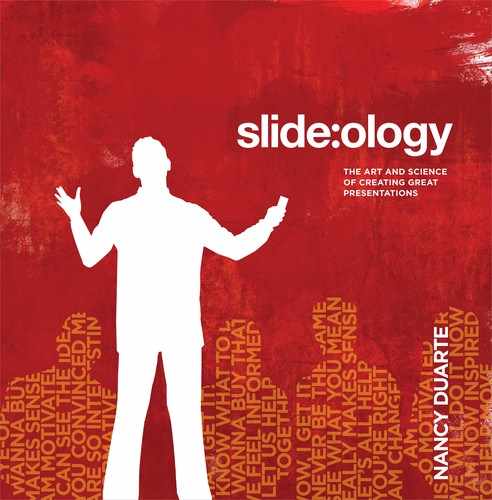
40 slide:ology
Sketching Complete Ideas
Now that you’ve generated several ideas,
begin to sketch pictures or scenes from
them. These sketches become visual trig-
gers that spark more ideas.
Don’t worry about throwing things away—that’s why
you generated a lot of ideas in the first place. In fact,
you’re ultimately going to have to throw all of them
away except for one. Designers recognize this as
the destructive aspect of the creative process; it’s
a good thing.
Some of the ideas you generate may require multiple
scenes built across a few slides versus a snapshot on
a single slide. On the other hand, sometimes it’s as
simple as using the perfect picture or diagram. Getting
your great idea across might require that you manipu-
late an image, create a custom illustration, or produce
a short video. Focus on whatever works best, not on
the idea that’s easiest to execute.
The sketching process should be loose and quick—doodles
really. Search through stock houses, magazines, even
YouTube for images and vignettes to reference while
sketching. Generate as many pictures as you can while
keeping in mind the slide layout; you want to ensure that
the elements work spatially in that format. In this way,
sketching serves as proof-of-concept because ideas that
are too complex, time-consuming, or costly will present
themselves as ripe for elimination.
There are plenty of dangers out
there, and it takes all you’ve got
to keep safe.
Script: The garden that is the
internet can be a dangerous place,
and you don’t always know when
<SNAP!> something bad is going
to happen.
If you sketch, it can sometimes be
difficult for others to imagine your
overall vision. Collecting images
that represent the feeling of the
final artwork often helps communi-
cate your intent.
© iStockphoto.com/Holly Jones

Creating Ideas, Not Slides 41
But what if someone was looking
out for you, taking care of menaces
and eliminating threats before they
become a problem?
That’s what our virus stopper was
designed to do—eliminate threats
and protect your data so you can
get back to business.
Now, find a colleague or two and walk them through your
sketches. Have them give you feedback on what works,
given your audience and personal style. They’ll likely have
insights that will improve your idea.
Here’s where it gets a bit more difficult. Depending on
the concept you’ve identified as the one best suited to
convey your idea, you may or may not have the skills to
execute the idea digitally. Be prepared to enlist the help
of a designer (you did plan far enough ahead to make
sure you’ve got one available, right?). There’s no shame
in seeking professional help, after all; what’s important is
effective communication, regardless of whether you have
the skill set to execute it.
T!P
Keep yourself visually and con-
ceptually fed by watching films,
visiting museums, and reading
design-related publications.
© iStockphoto.com/Simon Oxley, Yiying Lu
© iStockphoto.com/Andreea Manciu

..................Content has been hidden....................
You can't read the all page of ebook, please click here login for view all page.
